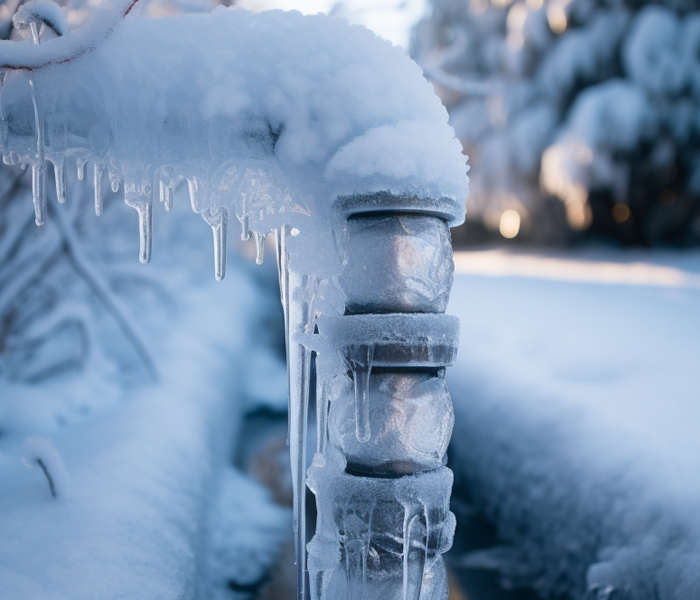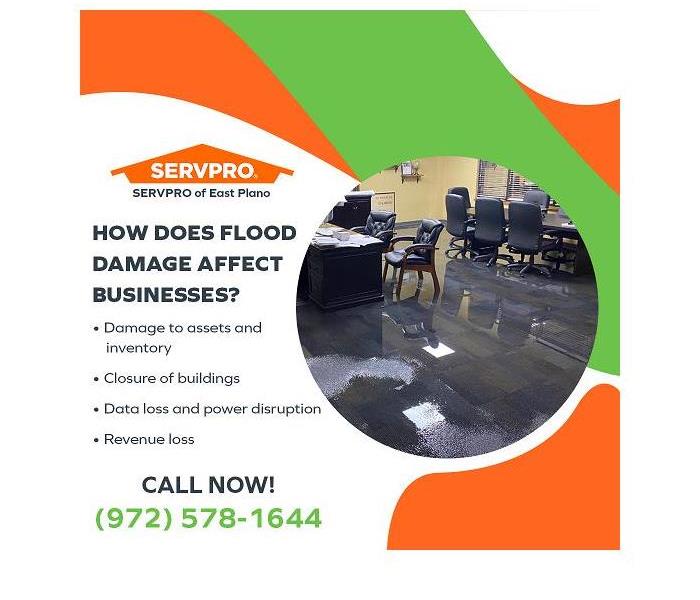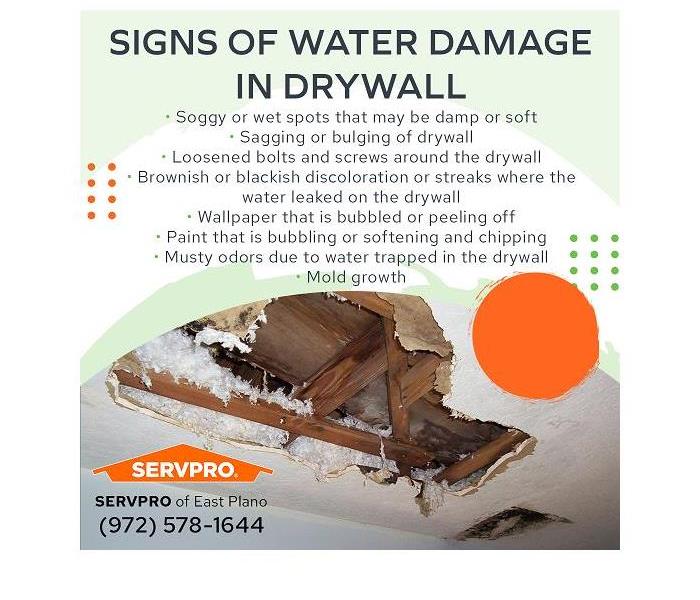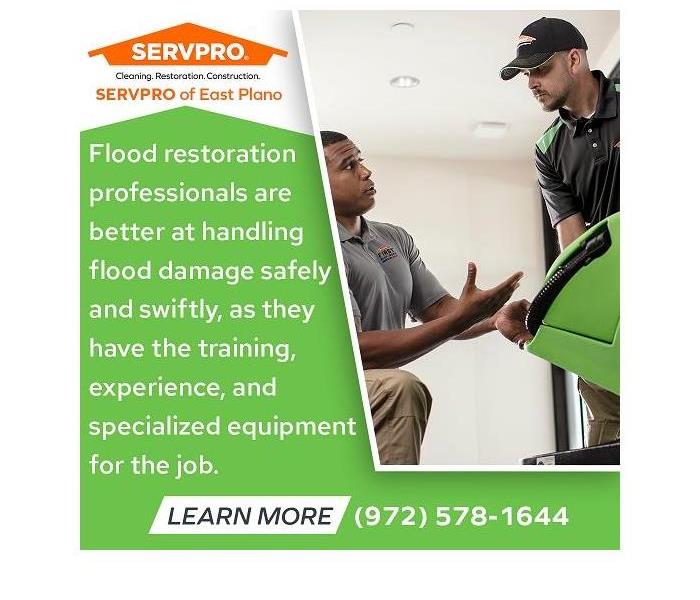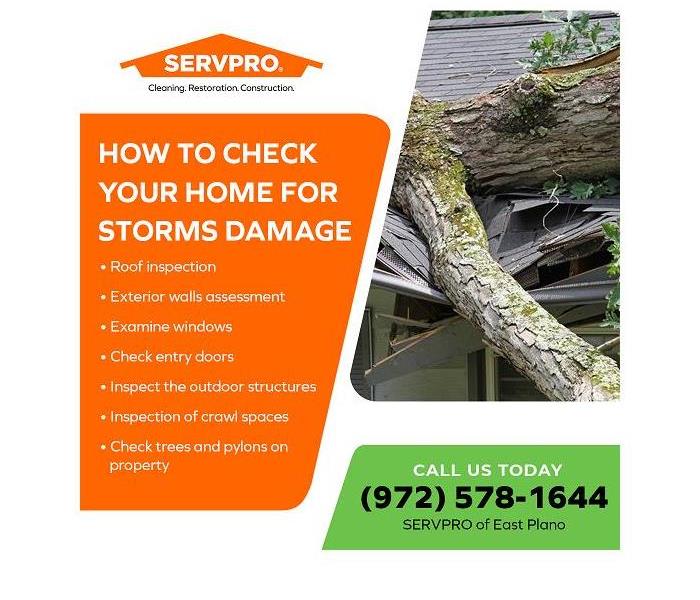Archived Storm Damage Blog Posts
Navigating Water Damage After the DFW Freeze
1/19/2024 (Permalink)
As the winter freeze tightens its grip on Dallas-Fort Worth (DFW), the risk of water damage becomes a real concern for homeowners and businesses alike. Team Shaw, your trusted emergency restoration experts in East Plano, are here to guide you through the crucial steps to take after encountering water damage during the DFW freeze. Prompt action is key to minimizing further damage and restoring your property to its pre-incident condition.
How to Respond to Water Leaks & Damage
Safety First:
The safety of you and your loved ones is paramount. If the water damage is extensive or poses electrical hazards, evacuate the premises and contact professionals like Team Shaw immediately.
Assess the Extent of Damage:
Once it's safe to do so, assess the extent of the water damage. Identify affected areas and take note of any potential hazards. This initial assessment will help Team Shaw tailor their restoration plan to your specific needs.
Document the Damage:
Take photographs and videos of the water-damaged areas. This documentation can be valuable for insurance claims and will serve as a reference point during the restoration process.
Turn Off Water Sources:
If the water damage is caused by a burst pipe or other plumbing issues, locate and turn off the main water supply to prevent further flooding.
Electricity Precautions:
Exercise caution around electrical appliances and outlets. If it's safe to do so, turn off the electricity in affected areas. Avoid using electrical appliances until Team Shaw has assessed and addressed potential electrical hazards.
Contact Team Shaw Immediately:
Time is of the essence when dealing with water damage. Contact Team Shaw promptly to initiate the emergency restoration process. Our 24/7 response team will be on-site quickly to assess the situation and implement effective solutions.
Water Extraction and Drying:
Team Shaw utilizes advanced equipment for efficient water extraction and drying. Swift action is crucial to prevent secondary issues such as mold growth.
Structural Repairs:
Our experienced technicians excel in structural repairs, ensuring that your property is not only restored but fortified against future challenges.
Mold Remediation:
Addressing water damage promptly is crucial to preventing mold growth. Team Shaw specializes in mold remediation, ensuring a healthy indoor environment.
Insurance Coordination:
Team Shaw will work with you to navigate the insurance process, providing documentation and support to streamline the claims process.
Encountering water damage during the DFW freeze can be overwhelming, but with Team Shaw by your side, you're not alone. By following these steps and reaching out to our experienced emergency restoration team, you can mitigate further damage and embark on the path to a swift and effective recovery. Trust Team Shaw to handle the aftermath of water damage, restoring your peace of mind and your property. Contact us 24/7 for professional and reliable emergency restoration services in East Plano.
Weathering the Storm: Safeguarding Your Property in DFW
1/11/2024 (Permalink)
Storms can strike unexpectedly, leaving a trail of damage and disruption in their wake. Residents and businesses in the Dallas-Fort Worth (DFW) area are no strangers to the power of Mother Nature. That being said, storm damage isn't inevitable.
To drive this point home, let's explore proactive steps to avoid storm damage to your property and provide a roadmap for recovery if you find yourself facing the aftermath of a tempest. We'll also highlight the importance of partnering with an emergency storm restoration company like SERVPRO Team Shaw to navigate the restoration process efficiently.
Preventing Storm Damage:
Regular Property Inspections: Regular inspections of your property, both inside and outside, can help identify vulnerable areas. Check for loose roof shingles, damaged siding, and weakened tree limbs that could pose a threat during a storm.
Tree Maintenance: Trim overhanging branches and remove dead or diseased trees. Strong winds can turn these into dangerous projectiles during a storm.
Gutter Maintenance: Clean gutters and downspouts regularly to ensure proper drainage. Clogged gutters can lead to water pooling and potential water damage.
Secure Outdoor Items: Secure outdoor furniture, potted plants, and other loose items. High winds can turn these objects into projectiles, causing damage to your property or neighboring structures.
Storm Shutters: If you live in an area prone to severe storms, consider installing storm shutters. These can provide an extra layer of protection for windows and doors.
Steps to Take After Storm Damage:
Assess Safety: Safety is the top priority. Check for any immediate dangers such as downed power lines or gas leaks. If it's safe, inspect your property for damage.
Document Damage: Take photographs and videos of the damage for insurance claims. This visual documentation will be crucial in the claims process.
Contact Emergency Services: If necessary, contact emergency services for immediate assistance. Once your safety is ensured, reach out to an emergency storm restoration company like SERVPRO Team Shaw.
SERVPRO Team Shaw: Your Restoration Partner: SERVPRO Team Shaw specializes in emergency storm restoration in the DFW area. Our experienced team is equipped to handle various storm-related damages, including water extraction, structural repairs, and debris removal.
Water Damage Mitigation: Storms often bring heavy rain, leading to water damage. SERVPRO Team Shaw employs advanced water extraction and drying techniques to prevent further destruction.
Structural Repairs: From roof repairs to addressing structural issues, SERVPRO Team Shaw ensures your property is restored to its pre-storm condition.
Debris Removal: Storms can leave behind a trail of debris. SERVPRO Team Shaw efficiently removes debris, helping to restore order to your property.
While we can't control the weather, taking proactive measures and knowing the steps to take after storm damage can significantly mitigate the impact on your property. Partnering with a trusted emergency storm restoration company like SERVPRO Team Shaw ensures that you have experienced professionals by your side, ready to restore your home or business to its former glory. Together, we can weather the storm and emerge stronger on the other side.
Tips to Help Businesses Recover After Flood Damage
1/18/2023 (Permalink)
Blog Summary: Tips to help businesses that have experienced flood damage are listed in this article by SERVPRO® of East Plano.
Flooding is a disaster that is devastating emotionally and financially for home and business owners. Flood damage cannot always be prevented, especially due to natural causes. Taking steps to minimize the immediate damage and planning for flood damage restoration to return to a preloss condition is the focus after flooding.
Flood water is considered contaminated and is a Category 3 water damage. It is safer when professionals handle the cleanup after any flood damage. East Plano and surrounding areas can experience stormy weather, like flash floods, hail, or tornadoes, that puts the community at risk of flood damage. SERVPRO of East Plano has highly trained storm damage specialists that offer flood restoration services in Bethany Lakes Park, TX, and surrounding areas. This locally owned and operated business is always prepared to respond to flood or storm damage emergencies. In this article, SERVPRO of East Plano provides some tips to help businesses facing flood damage.
How does flood damage affect businesses?
Flooding causes disruptions to businesses by different means, including the following:
Damage to assets and inventory: There can be damages to machines, merchandise, vehicles, or devices that take time to replace or repair.
Closure of buildings: when flood water enters a building, the cleanup can take time, during which the building may be closed for safety.
Data loss and power disruption: Flood water can damage electrical systems and electronic devices like computers. It can be impossible to repair electronics sometimes, which is why data backups are crucial for businesses.
Revenue loss: the loss of inventory and equipment and the time and money needed for flood damage restoration services can cost a considerable amount. Also, during the flood damage restoration process, the business may be closed or need alternative arrangements which impact the revenue.
What to do to recover from flood damage
Flood damage can have a prolonged impact on a business, depending on the extent of the damage. Hence, it benefits businesses to plan for a flood and the flood cleanup after that, primarily if located in an area at risk of floods. The following are some measures that will help in the aftermath of flood damage.
Have an emergency response plan for disasters, including flooding
The emergency response plan should include all the data and documents like contact information for employees and emergency services, inventory lists, etc.
Do regular backups
Ensure that a data backup is done regularly.
Research on available resources
Check the assistance options available for businesses in the event of a flood. FEMA, United Way, and the US Chamber of Commerce offer assistance and resources to businesses for flood recovery. Local and state governments may also have programs to help businesses affected by flood damage.
Get professional flood damage restoration services
Businesses with flood insurance policies must keep them up to date. Knowing local flood restoration services with a good reputation will help in the event of a disaster.
Protect assets from floods
Businesses can take steps to protect themselves from flood damage, like relocating to an area less prone to floods, floodproofing the building, building floodwalls, and elevating the building.
Being prepared may mean the battle is half-won. But, the battle may still have to be fought. Despite the best precautions, businesses can be affected by flood damage. Flood damage restoration done by professionals helps to resume business as usual as soon as possible. SERVPRO of East Plano offers residential and commercial flood damage restoration services in Bethany Lakes Park, TX. As a leader in the storm and water damage restoration industry, the company has a team of experts with the training and expertise to handle flood damage. The flood damage restoration process uses scientific drying techniques and monitors and documents the entire process. Business owners and residents who need flood damage restoration services in Bethany Lakes Park, TX, can contact SERVPRO of East at (972) 578-1644. The company offers 24-hour emergency services and is quick to respond to disasters of any size.
Does Drywall Need To Be Replaced After Flood Damage?
11/10/2022 (Permalink)
Blog Summary: SERVPRO® of East Plano shares some insight into whether drywall needs to be replaced after flood damage.
Homes can get flooded due to several reasons. Flood damage usually occurs due to water from a natural disaster (hurricane, heavy rain), including flash flooding, sump failure, roof leaks, etc. Flooding can result in a devastating situation that will probably need water damage restoration services.
Water damage refers to the losses that water intrusion causes, which enables the destruction of materials or objects. Destructive processes due to water can be the rotting of wood, rusting of metal, mold growth, etc. Drywall is a building material susceptible to water damage when flooding occurs. It is made up of sheets of gypsum board. It is used extensively in residential and commercial construction. Though it is sturdy, drywall is porous and can absorb water when exposed for long. Drywall is most likely to sustain water damage when it is exposed to water for any period of time. In this article, SERVPRO of East Plano explains why drywall needs to be replaced after flood damage. SERVPRO of East Plano is a locally owned and operated business that provides water damage restoration in Plano, TX, and surrounding areas. Their highly trained water damage restoration technicians use state-of-the-art equipment for water extraction and drying property. SERVPRO of East Plano ensures the swift restoration of residential and commercial property.
Signs of water damage in drywall
- Soggy or wet spots that may be damp or soft
- Sagging or bulging of drywall
- Loosened bolts and screws around the drywall
- Brownish or blackish discoloration or streaks where the water leaked on the drywall
- Wallpaper that is bubbled or peeling off
- Paint that is bubbling or softening and chipping
- Mold growth
- Musty odors due to water trapped in the drywall
When should drywall be replaced?
The drywall must be inspected thoroughly after any flooding or suspected water damage. If the flooding is major, the probability of water damage is high.
Slight dampness of drywall
If the drywall is only slightly damp, it may not need to be replaced. However, drying the drywall swiftly is essential. Pointing fans to the drywall may help dry it after stopping the water source. Opening windows may help circulate air and dry the drywall if the climate is not too wet and humid.
Soggy drywall
Since drywall is porous, it absorbs water. The more time it is exposed to water, the more water the drywall absorbs. When the drywall is soggy or starts to sag or bulge, it means a lot of water has been absorbed. The deformed drywall needs to be removed as it can collapse. Wet drywall can also lead to mold growth. Water damage restoration professionals recommend that wet drywall be replaced within 48 hours, as mold growth starts when surfaces remain moist for more than 24 to 48 hours.
Mold growth
Sometimes water damage may seem insignificant immediately, and the drywall may not appear wet. But, mold growth may occur later. Small black spots may appear on the surface, or a musty odor may be emitted. When mold is suspected, a water damage restoration specialist is needed to remove and replace drywall. These personnel are trained and have the protective equipment and devices to quickly, effectively, and safely handle water damage.
Replacing drywall may be simple for some. But, if the water damage was due to flood water that is considered to be contaminated, or there is a risk of mold growth, a water damage restoration company can be called in. They will remove and replace drywall without compromising on safety while ensuring the integrity of the structure of the building is improved. SERVPRO of East Plano is a trusted leader in the water damage restoration industry. Their skilled team provides customized solutions for residential and commercial water damage restoration needs. Irrespective of the size of the disaster, businesses, and homeowners who need water damage restoration in Plano, TX, and surrounding areas can contact SERVPRO® of East Plano on the phone number (972) 578-1644.
Steps Homeowners Should Take After a Flood
10/18/2022 (Permalink)
Blog Summary: The steps homeowners should take after a flood are listed by SERVPRO of East Plano.
A temporary overflow of water onto land that is usually dry is termed flooding. With the changes in the environment and climate, floods are the most common natural disaster in the US. Floods can be devastating and lead to dangers even after they are over. This is why flood damage must be handled properly. The aftermath of flooding can be stressful, and a professional flood restoration service would help make dealing with the situation easier and safer for homeowners.
SERVPRO® of East Plano is one of the trusted leaders in the restoration industry and offers storm damage and cleanup and flood restoration services in Parker, TX, and surrounding areas. As it is a locally operated company that is part of an extensive network, SERVPRO can handle disasters of any size and is always quick to reach. In this article, SERVPRO of East Plano shares what homeowners can do after a flood to stay safe and limit the damage. In places like Texas, flooding can happen near creeks, bayous, coasts, and river shorelines. Severe weather, like storms, heavy wind, and rain, can all increase the risk of flooding. Managing flood risk and responding to floods are expensive steps. It is essential that homeowners and businesses should take measures to minimize flood damage and stay safe during and after floods.
The instructions from authorities must be followed at all times in a flood situation, including when evacuation is needed and when to return after the flood. When venturing into flooded areas, personal protection should be taken care of. Wearing heavy gloves, boots, and protective clothes will help avoid contact with floodwater that is considered to be contaminated. When cleaning flood-affected areas, it is best to use a face mask if mold or debris may be present. However, flood restoration professionals are better at handling flood damage safely and swiftly, as they have the training, experience, and specialized equipment for the job.
Steps to take when returning home after a flood
- Carefully inspect and observe the interiors and exteriors of the home for any damage that may be unsafe after flood damage, like any structure that is weak and may collapse.
- Children and people with health issues must not enter flooded homes or areas where mold growth is suspected.
- Since exposure to water can cause electrical hazards, turn off the electricity supply if that can be done safely. It is safer to avoid any contact with electrical equipment if they may have been exposed to water. If there is the possibility of wires in areas where there is standing water, people must not venture into that place. Professionals can handle this safely with precautions to avoid accidents due to electrocution.
- When entering a home for the first time after a flood, matches or cigarette lighters must not be used. Gas may be trapped in buildings and may be inflammable.
- If possible, the water source must be turned off or sealed off.
- Call for help if needed to get the recovery process started. Renters may call their landlords to update them. Homeowners with flood insurance can contact their insurers to inform them that flood damage has occurred and flood restoration may be needed. It is best to confirm if the adjuster has to visit the home before the cleanup and flood restoration begins.
- Before starting cleanup, it is good to document the damage so that there is a record and proof of the extent of the water damage. Photos or videos will be helpful.
- Do not use flood water for anything, including washing dishes or cooking. Follow local authorities' instructions to know when the water supply is safe for drinking and bathing. Until authorities give the green signal, avoid using the water supply. Bottled, boiled, or treated water must be used for drinking, cooking, etc.
- All food and bottled water that may have been in contact with floodwater must be discarded.
The above are just initial steps taken when returning to a home affected by floods. Further measures must be taken to clean flood-damaged homes. Though information on flood cleanup is available, a professional flood restoration service is better equipped to restore a flood-damaged home. Flood restoration in Parker, TX, is handled exceptionally efficiently by SERVPRO® of East Plano. They have highly trained technicians, and their emergency services are available 24/7, 365 days a year. SERVPRO of East Plano understands that flooding and water emergencies do not wait for business hours and are particular that emergency services respond immediately to disasters. Contact SERVPRO of East Plano at (972) 578-1644 at any time, on any day of the week, for fire and water emergencies.
Flood Restoration 101: How to Check Your Home for Storm Damage
10/9/2022 (Permalink)
Blog Summary: SERVPRO of East Plano explains how to check for storm damage in homes.
Homes and businesses across the US are increasingly at risk of flood damage in comparison to the past. Flooding is a very distressing experience and flood damage can be devastating for both families and businesses. Taking immediate action to limit flood damage is necessary for safety and to reduce additional costs incurred for worse damage.
Flood damage can be caused by severe thunderstorms, heavy rainfall, hurricanes, and adverse weather conditions. Flood water can rise due to remote events like snowcaps melting off mountains that are far away. Flooding can happen from causes within a building like broken pipes, faulty appliances, sewer backups, etc.
Storms are any type of disturbance in the environment or atmosphere that strongly contribute to severe weather. Storms are of different types and can include thunderstorms (heavy wind, thunder, lightning, hail), snowstorms, rainstorms, strong winds (cyclones, hurricanes, tornadoes), etc.
The process of removing water, decontaminating the area affected, and making the building or property safe enough to carry out repairs, is flood restoration. Flood water is considered to be contaminated, and hazardous. People and animals must be kept away from exposure to it. This is why flood restoration is a job for a professional water damage restoration company that is equipped to handle storm damage and flood restoration. SERVPRO of East Plano has highly-trained professionals capable of providing flood restoration services in Parker, TX. Some ways to check for storm damage are shared in this article by SERVPRO® of East Plano for the benefit of homeowners who need flood restoration.
Stormy weather can bring heavy rains, strong winds, and lightning which are all capable of damaging property. Damaged windows and roofs are very common after storms, and can lead to water damage. Even when a home appears intact after a storm, it is better to check for hidden storm damage. This will help start storm damage repair as early as possible, which is better for safety and keeping costs low. Storm damage can be identified by checking the following:
1. Roof Inspection
Roofs are at high risk for damage during storms. Heavy rains, winds, and airborne objects like tree branches, can all cause damage to this structure. The roof must be checked for signs of storm damage like broken, curling, or missing shingles, gaps between tiles, debris like leaves or twigs in the gutters or downspouts, and damage to the chimney.
2. Exterior Walls Assessment
Walls must be carefully examined for signs that indicate storm damage that is not obvious. These include cracking that radiates from a point in a spider pattern, splitting or breaking, chipping of paint, small holes or dents, and discolored, damaged, or missing sidings. The walls must be checked on the inside and outside for damp patches.
3. Examine Windows
Windows can be shattered in storms causing interior damage by the broken glass and allowing water to enter the building. Though at a casual glance windows may not appear broken, they must be examined meticulously for small cracks, loose glass panes, and damaged window frames that have small dents or cracks. Sturdy gloves can be used when inspecting windows to avoid injury. Boarding up windows temporarily with plywood will reduce further damage and protect the interiors from natural elements.
4. Check Entry Doors
Entry doors can be subjected to strain by heavy winds and water flow. This can cause them to fall off their hinges, break, or develop cracks and holes. A damaged door will expose the home to water and other unwanted elements.
5. Inspect The Outdoor Structures
External wooden structures like decks, porches, and fences can sustain storm damage. The area surrounding the structures must be checked for dampness and water pooling. The structures must be checked for cracking, chipping, and other damages like warped boards. Check for missing planks, railings, steps, etc. Loose boards can be secured with screws and debris cleared.
6. Inspection Of Crawl Spaces
Crawl spaces can harbor flooding and excess moisture after a storm. If left unattended, this can cause costly damages. Roof leaks, leaky doors, pipe leaks, and condensation can all allow water to enter crawl spaces. Check for signs like musty smells, pests, saggy or sloped floors, etc., in the crawl spaces. These indicate flood restoration is needed.
7. Check Trees and Pylons On the Property
Pylons on the property and nearby must be checked for damage caused by the storm that can lead to a power outage. If broken cables or tilting pylons are noticed, the utility office must be notified. Trees must be checked for loose branches that can cause danger.
Minor repairs may be handled by homeowners. But if there are signs like cracking on walls or signs of insulation damage that allow moisture in, experts will need to be called. If flooding has occurred, flood restoration needs to be done by professionals who have the experience and skills needed to handle it swiftly and efficiently. For storm damage repair in Parker, TX, homeowners or business owners can contact SERVPRO of East Plano. Whether the storm damage is minor or severe, this property damage restoration company is equipped and experienced enough to provide flood restoration services. They belong to the SERVPRO® network which is the number one choice in the restoration industry. SERVPRO of East Plano has highly trained restoration technicians available 24/7. They respond to emergencies like storm and flood damage immediately and help speed up the insurance process for customers.






 24/7 Emergency Service
24/7 Emergency Service
